Effective Leadership in Health and Social Care: A Comprehensive Report
VerifiedAdded on 2022/12/28
|15
|3896
|71
Report
AI Summary
This report delves into the critical aspects of leading teams within health and social care settings. It begins by defining motivation and exploring various motivational approaches, including monetary and non-monetary incentives, and relevant leadership theories like McClelland's need theory. The report then examines the essential role of leadership in guiding teams, building morale, and promoting team values, along with outlining the roles of a leader. Furthermore, it highlights the value of theoretical models, such as the Belbin Team Roles model, in constructing successful teams, as well as the importance of conflict management and emotional intelligence. It also discusses the skills needed to build effective teams. The report also addresses the stages of team development and the corresponding leadership styles necessary for achieving successful project outcomes, and concludes with recommendations for fostering open communication among team members to support team development. The report also explores the principles that staff in a care setting expect and need from a leader.
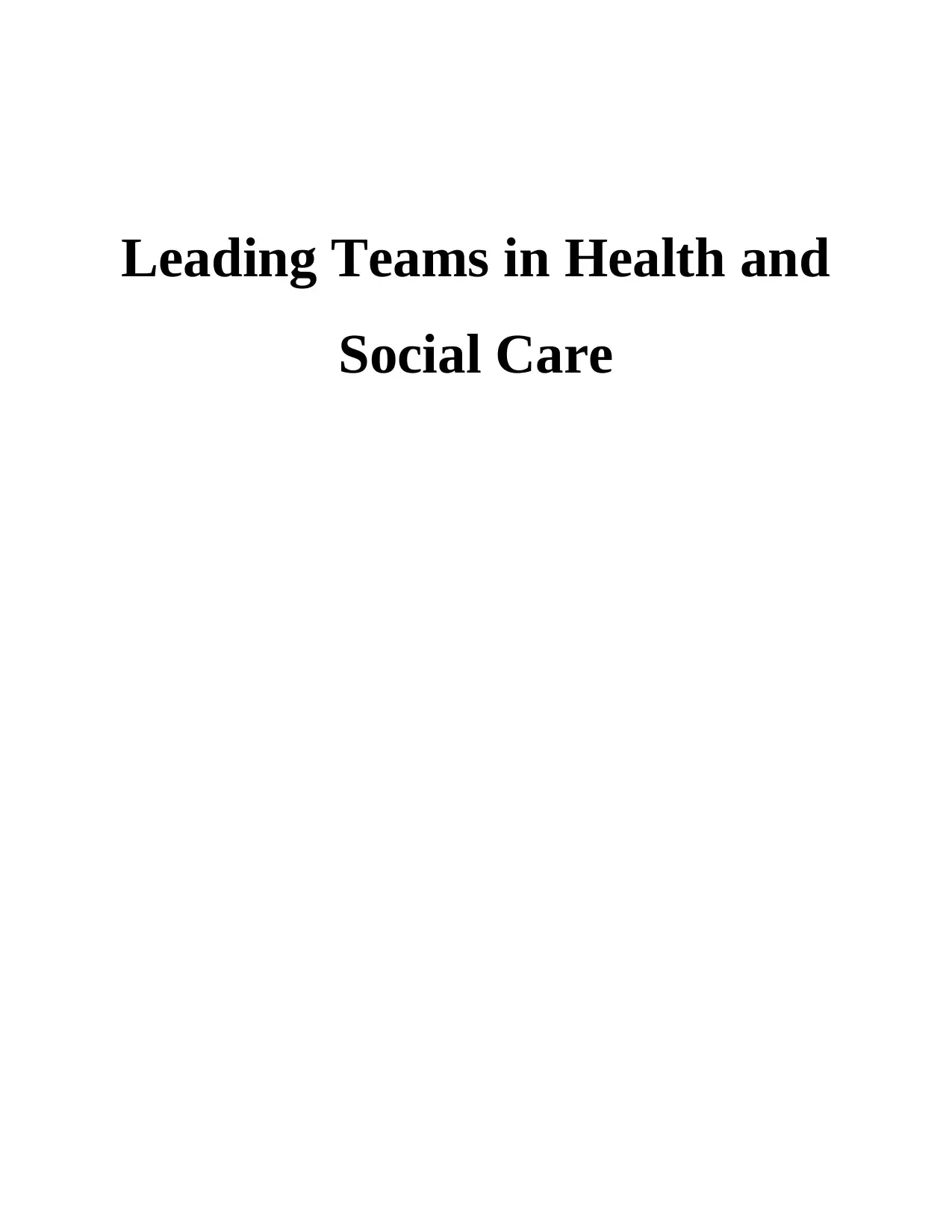
Leading Teams in Health and
Social Care
Social Care
Paraphrase This Document
Need a fresh take? Get an instant paraphrase of this document with our AI Paraphraser
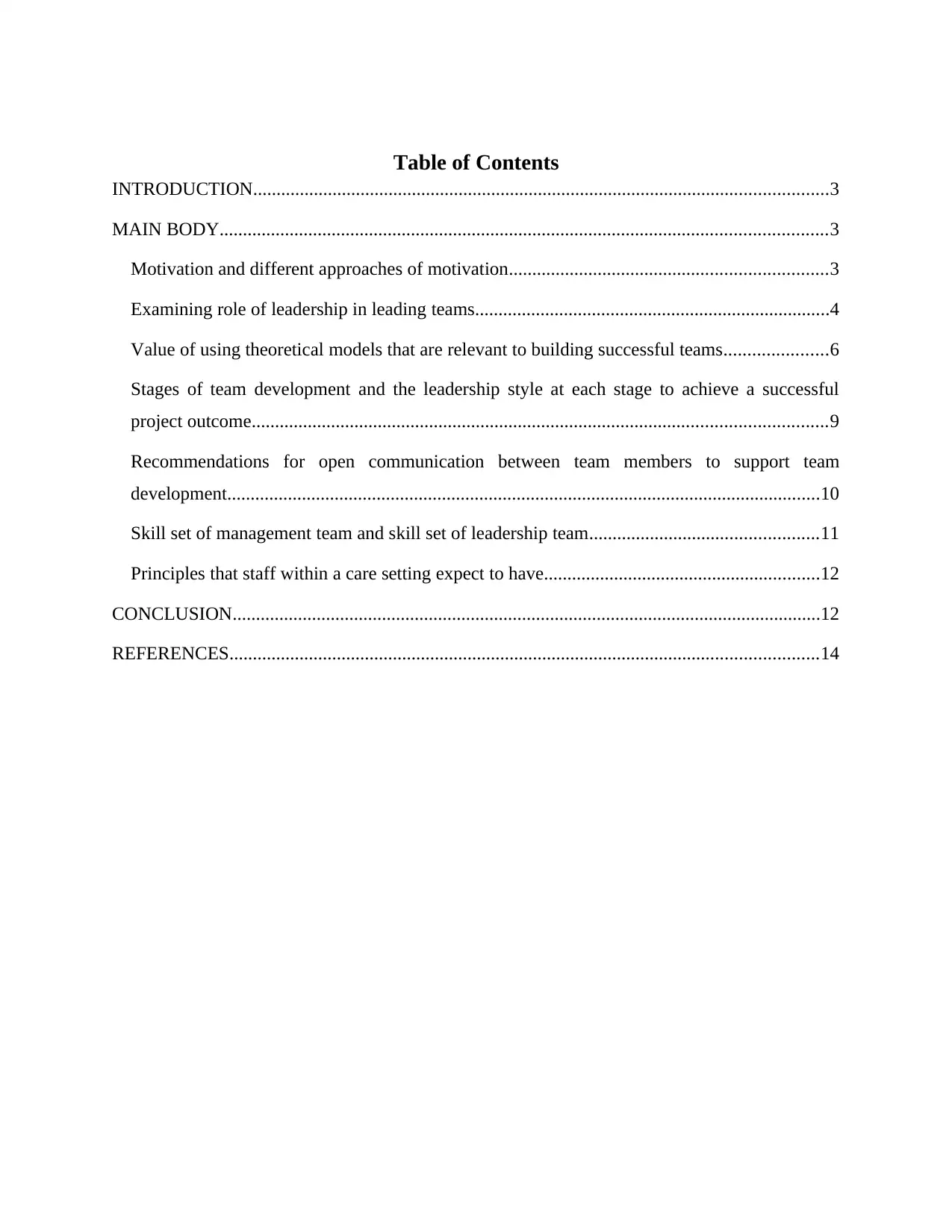
Table of Contents
INTRODUCTION...........................................................................................................................3
MAIN BODY..................................................................................................................................3
Motivation and different approaches of motivation....................................................................3
Examining role of leadership in leading teams............................................................................4
Value of using theoretical models that are relevant to building successful teams......................6
Stages of team development and the leadership style at each stage to achieve a successful
project outcome...........................................................................................................................9
Recommendations for open communication between team members to support team
development...............................................................................................................................10
Skill set of management team and skill set of leadership team.................................................11
Principles that staff within a care setting expect to have...........................................................12
CONCLUSION..............................................................................................................................12
REFERENCES..............................................................................................................................14
INTRODUCTION...........................................................................................................................3
MAIN BODY..................................................................................................................................3
Motivation and different approaches of motivation....................................................................3
Examining role of leadership in leading teams............................................................................4
Value of using theoretical models that are relevant to building successful teams......................6
Stages of team development and the leadership style at each stage to achieve a successful
project outcome...........................................................................................................................9
Recommendations for open communication between team members to support team
development...............................................................................................................................10
Skill set of management team and skill set of leadership team.................................................11
Principles that staff within a care setting expect to have...........................................................12
CONCLUSION..............................................................................................................................12
REFERENCES..............................................................................................................................14
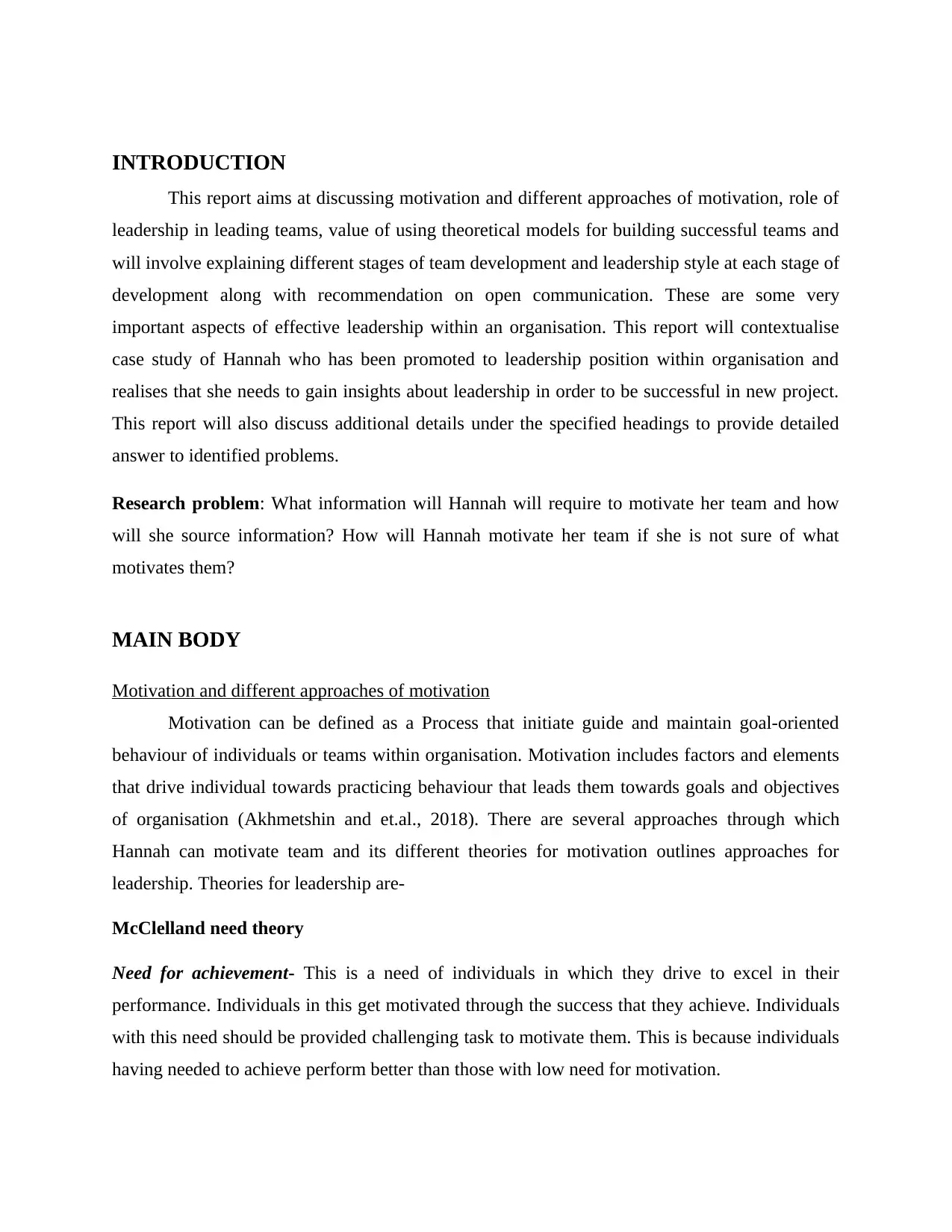
INTRODUCTION
This report aims at discussing motivation and different approaches of motivation, role of
leadership in leading teams, value of using theoretical models for building successful teams and
will involve explaining different stages of team development and leadership style at each stage of
development along with recommendation on open communication. These are some very
important aspects of effective leadership within an organisation. This report will contextualise
case study of Hannah who has been promoted to leadership position within organisation and
realises that she needs to gain insights about leadership in order to be successful in new project.
This report will also discuss additional details under the specified headings to provide detailed
answer to identified problems.
Research problem: What information will Hannah will require to motivate her team and how
will she source information? How will Hannah motivate her team if she is not sure of what
motivates them?
MAIN BODY
Motivation and different approaches of motivation
Motivation can be defined as a Process that initiate guide and maintain goal-oriented
behaviour of individuals or teams within organisation. Motivation includes factors and elements
that drive individual towards practicing behaviour that leads them towards goals and objectives
of organisation (Akhmetshin and et.al., 2018). There are several approaches through which
Hannah can motivate team and its different theories for motivation outlines approaches for
leadership. Theories for leadership are-
McClelland need theory
Need for achievement- This is a need of individuals in which they drive to excel in their
performance. Individuals in this get motivated through the success that they achieve. Individuals
with this need should be provided challenging task to motivate them. This is because individuals
having needed to achieve perform better than those with low need for motivation.
This report aims at discussing motivation and different approaches of motivation, role of
leadership in leading teams, value of using theoretical models for building successful teams and
will involve explaining different stages of team development and leadership style at each stage of
development along with recommendation on open communication. These are some very
important aspects of effective leadership within an organisation. This report will contextualise
case study of Hannah who has been promoted to leadership position within organisation and
realises that she needs to gain insights about leadership in order to be successful in new project.
This report will also discuss additional details under the specified headings to provide detailed
answer to identified problems.
Research problem: What information will Hannah will require to motivate her team and how
will she source information? How will Hannah motivate her team if she is not sure of what
motivates them?
MAIN BODY
Motivation and different approaches of motivation
Motivation can be defined as a Process that initiate guide and maintain goal-oriented
behaviour of individuals or teams within organisation. Motivation includes factors and elements
that drive individual towards practicing behaviour that leads them towards goals and objectives
of organisation (Akhmetshin and et.al., 2018). There are several approaches through which
Hannah can motivate team and its different theories for motivation outlines approaches for
leadership. Theories for leadership are-
McClelland need theory
Need for achievement- This is a need of individuals in which they drive to excel in their
performance. Individuals in this get motivated through the success that they achieve. Individuals
with this need should be provided challenging task to motivate them. This is because individuals
having needed to achieve perform better than those with low need for motivation.
⊘ This is a preview!⊘
Do you want full access?
Subscribe today to unlock all pages.

Trusted by 1+ million students worldwide
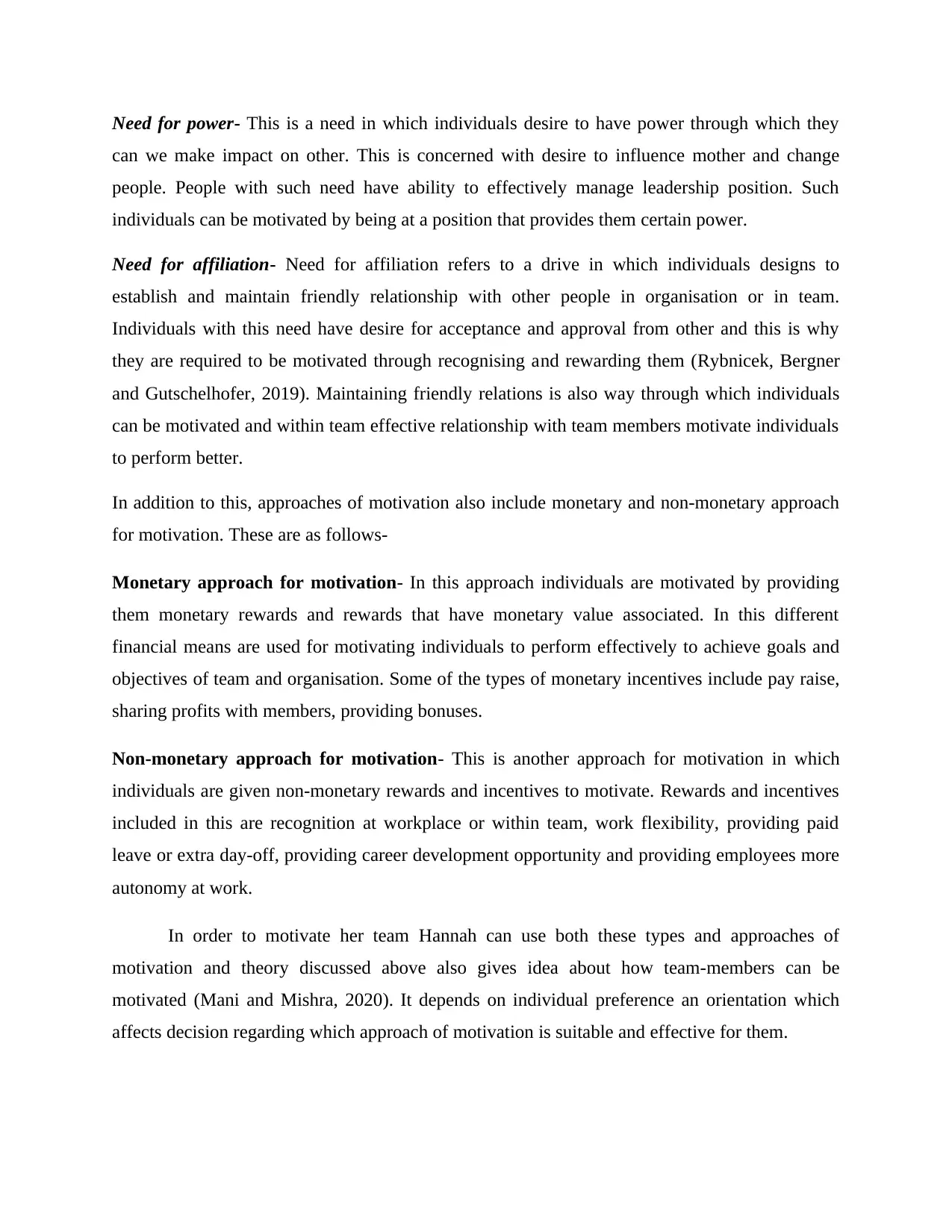
Need for power- This is a need in which individuals desire to have power through which they
can we make impact on other. This is concerned with desire to influence mother and change
people. People with such need have ability to effectively manage leadership position. Such
individuals can be motivated by being at a position that provides them certain power.
Need for affiliation- Need for affiliation refers to a drive in which individuals designs to
establish and maintain friendly relationship with other people in organisation or in team.
Individuals with this need have desire for acceptance and approval from other and this is why
they are required to be motivated through recognising and rewarding them (Rybnicek, Bergner
and Gutschelhofer, 2019). Maintaining friendly relations is also way through which individuals
can be motivated and within team effective relationship with team members motivate individuals
to perform better.
In addition to this, approaches of motivation also include monetary and non-monetary approach
for motivation. These are as follows-
Monetary approach for motivation- In this approach individuals are motivated by providing
them monetary rewards and rewards that have monetary value associated. In this different
financial means are used for motivating individuals to perform effectively to achieve goals and
objectives of team and organisation. Some of the types of monetary incentives include pay raise,
sharing profits with members, providing bonuses.
Non-monetary approach for motivation- This is another approach for motivation in which
individuals are given non-monetary rewards and incentives to motivate. Rewards and incentives
included in this are recognition at workplace or within team, work flexibility, providing paid
leave or extra day-off, providing career development opportunity and providing employees more
autonomy at work.
In order to motivate her team Hannah can use both these types and approaches of
motivation and theory discussed above also gives idea about how team-members can be
motivated (Mani and Mishra, 2020). It depends on individual preference an orientation which
affects decision regarding which approach of motivation is suitable and effective for them.
can we make impact on other. This is concerned with desire to influence mother and change
people. People with such need have ability to effectively manage leadership position. Such
individuals can be motivated by being at a position that provides them certain power.
Need for affiliation- Need for affiliation refers to a drive in which individuals designs to
establish and maintain friendly relationship with other people in organisation or in team.
Individuals with this need have desire for acceptance and approval from other and this is why
they are required to be motivated through recognising and rewarding them (Rybnicek, Bergner
and Gutschelhofer, 2019). Maintaining friendly relations is also way through which individuals
can be motivated and within team effective relationship with team members motivate individuals
to perform better.
In addition to this, approaches of motivation also include monetary and non-monetary approach
for motivation. These are as follows-
Monetary approach for motivation- In this approach individuals are motivated by providing
them monetary rewards and rewards that have monetary value associated. In this different
financial means are used for motivating individuals to perform effectively to achieve goals and
objectives of team and organisation. Some of the types of monetary incentives include pay raise,
sharing profits with members, providing bonuses.
Non-monetary approach for motivation- This is another approach for motivation in which
individuals are given non-monetary rewards and incentives to motivate. Rewards and incentives
included in this are recognition at workplace or within team, work flexibility, providing paid
leave or extra day-off, providing career development opportunity and providing employees more
autonomy at work.
In order to motivate her team Hannah can use both these types and approaches of
motivation and theory discussed above also gives idea about how team-members can be
motivated (Mani and Mishra, 2020). It depends on individual preference an orientation which
affects decision regarding which approach of motivation is suitable and effective for them.
Paraphrase This Document
Need a fresh take? Get an instant paraphrase of this document with our AI Paraphraser
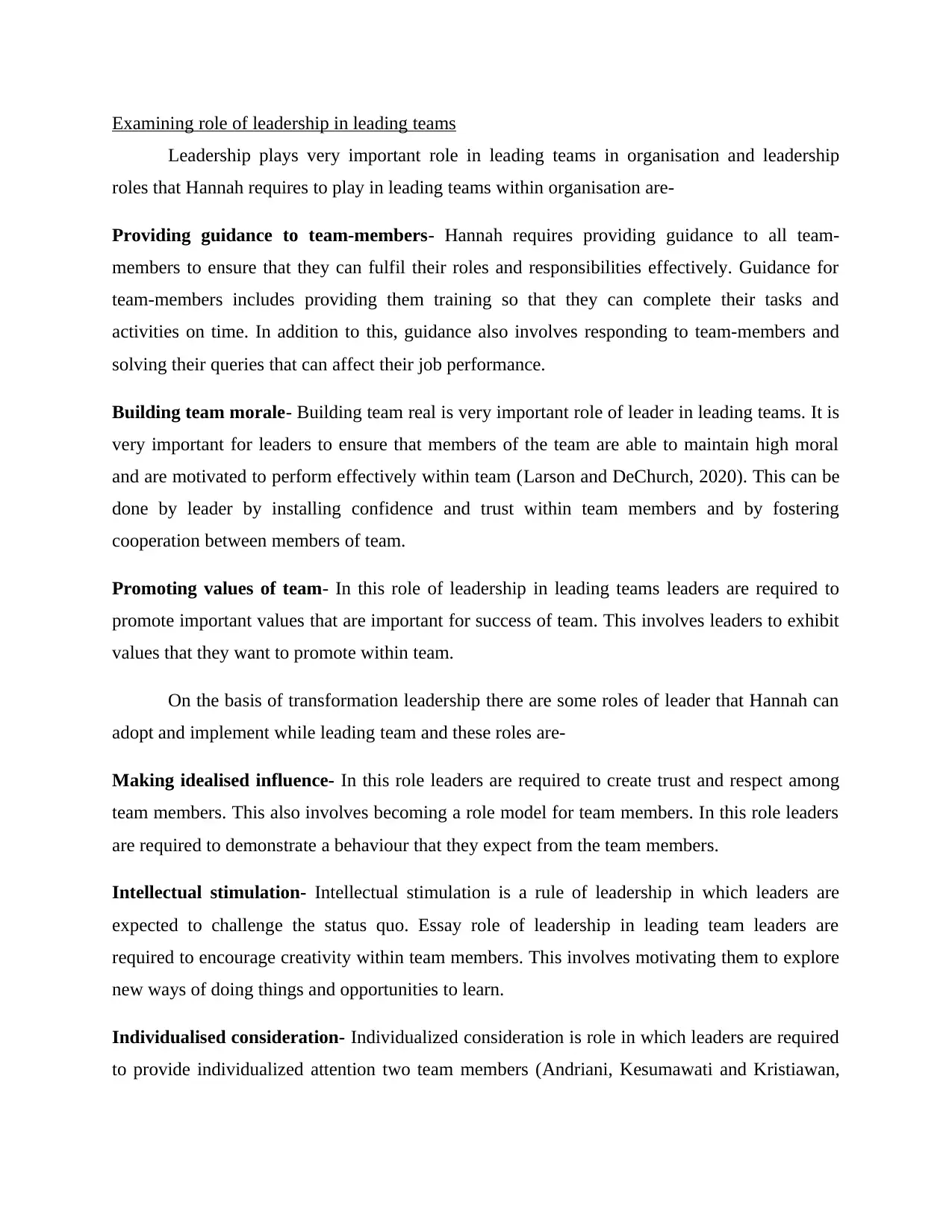
Examining role of leadership in leading teams
Leadership plays very important role in leading teams in organisation and leadership
roles that Hannah requires to play in leading teams within organisation are-
Providing guidance to team-members- Hannah requires providing guidance to all team-
members to ensure that they can fulfil their roles and responsibilities effectively. Guidance for
team-members includes providing them training so that they can complete their tasks and
activities on time. In addition to this, guidance also involves responding to team-members and
solving their queries that can affect their job performance.
Building team morale- Building team real is very important role of leader in leading teams. It is
very important for leaders to ensure that members of the team are able to maintain high moral
and are motivated to perform effectively within team (Larson and DeChurch, 2020). This can be
done by leader by installing confidence and trust within team members and by fostering
cooperation between members of team.
Promoting values of team- In this role of leadership in leading teams leaders are required to
promote important values that are important for success of team. This involves leaders to exhibit
values that they want to promote within team.
On the basis of transformation leadership there are some roles of leader that Hannah can
adopt and implement while leading team and these roles are-
Making idealised influence- In this role leaders are required to create trust and respect among
team members. This also involves becoming a role model for team members. In this role leaders
are required to demonstrate a behaviour that they expect from the team members.
Intellectual stimulation- Intellectual stimulation is a rule of leadership in which leaders are
expected to challenge the status quo. Essay role of leadership in leading team leaders are
required to encourage creativity within team members. This involves motivating them to explore
new ways of doing things and opportunities to learn.
Individualised consideration- Individualized consideration is role in which leaders are required
to provide individualized attention two team members (Andriani, Kesumawati and Kristiawan,
Leadership plays very important role in leading teams in organisation and leadership
roles that Hannah requires to play in leading teams within organisation are-
Providing guidance to team-members- Hannah requires providing guidance to all team-
members to ensure that they can fulfil their roles and responsibilities effectively. Guidance for
team-members includes providing them training so that they can complete their tasks and
activities on time. In addition to this, guidance also involves responding to team-members and
solving their queries that can affect their job performance.
Building team morale- Building team real is very important role of leader in leading teams. It is
very important for leaders to ensure that members of the team are able to maintain high moral
and are motivated to perform effectively within team (Larson and DeChurch, 2020). This can be
done by leader by installing confidence and trust within team members and by fostering
cooperation between members of team.
Promoting values of team- In this role of leadership in leading teams leaders are required to
promote important values that are important for success of team. This involves leaders to exhibit
values that they want to promote within team.
On the basis of transformation leadership there are some roles of leader that Hannah can
adopt and implement while leading team and these roles are-
Making idealised influence- In this role leaders are required to create trust and respect among
team members. This also involves becoming a role model for team members. In this role leaders
are required to demonstrate a behaviour that they expect from the team members.
Intellectual stimulation- Intellectual stimulation is a rule of leadership in which leaders are
expected to challenge the status quo. Essay role of leadership in leading team leaders are
required to encourage creativity within team members. This involves motivating them to explore
new ways of doing things and opportunities to learn.
Individualised consideration- Individualized consideration is role in which leaders are required
to provide individualized attention two team members (Andriani, Kesumawati and Kristiawan,
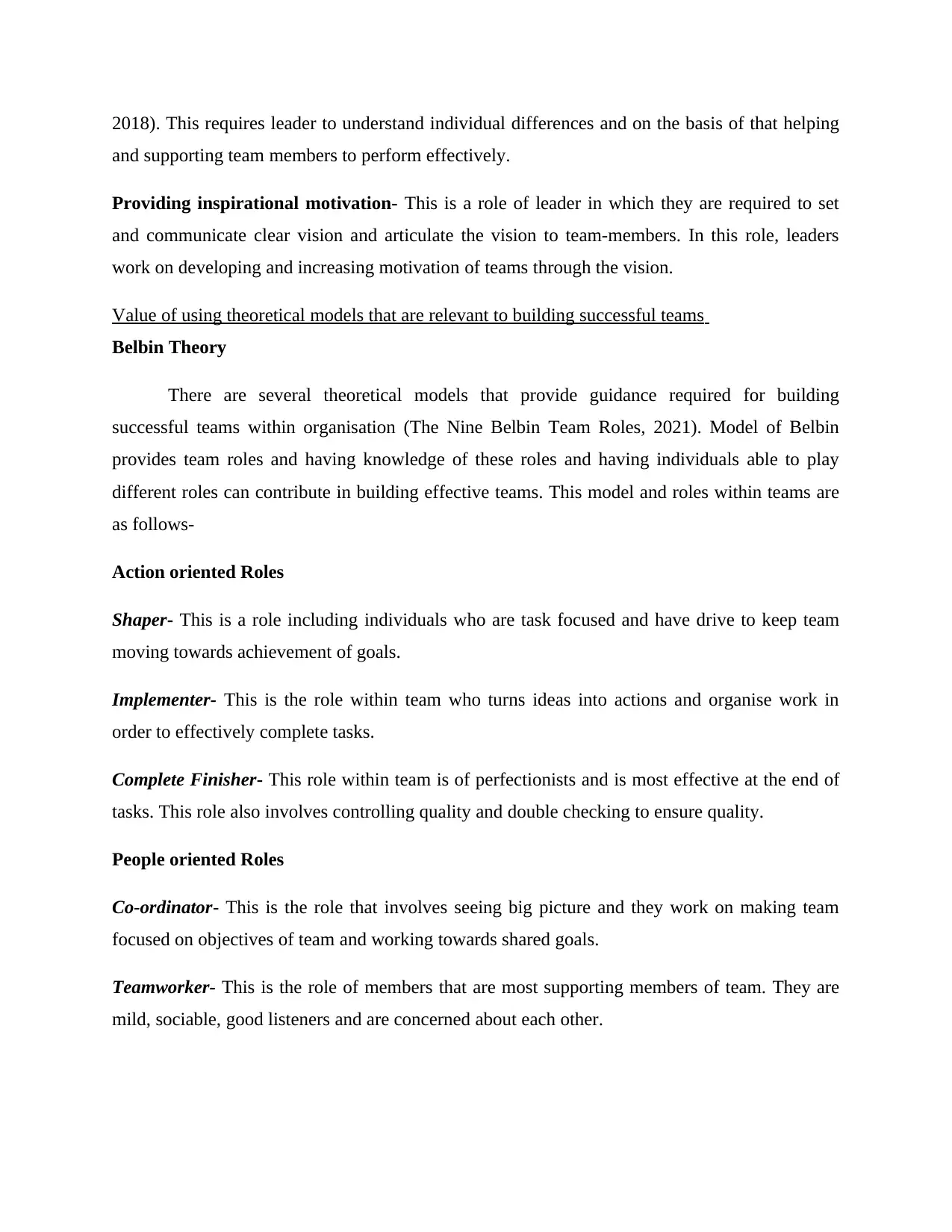
2018). This requires leader to understand individual differences and on the basis of that helping
and supporting team members to perform effectively.
Providing inspirational motivation- This is a role of leader in which they are required to set
and communicate clear vision and articulate the vision to team-members. In this role, leaders
work on developing and increasing motivation of teams through the vision.
Value of using theoretical models that are relevant to building successful teams
Belbin Theory
There are several theoretical models that provide guidance required for building
successful teams within organisation (The Nine Belbin Team Roles, 2021). Model of Belbin
provides team roles and having knowledge of these roles and having individuals able to play
different roles can contribute in building effective teams. This model and roles within teams are
as follows-
Action oriented Roles
Shaper- This is a role including individuals who are task focused and have drive to keep team
moving towards achievement of goals.
Implementer- This is the role within team who turns ideas into actions and organise work in
order to effectively complete tasks.
Complete Finisher- This role within team is of perfectionists and is most effective at the end of
tasks. This role also involves controlling quality and double checking to ensure quality.
People oriented Roles
Co-ordinator- This is the role that involves seeing big picture and they work on making team
focused on objectives of team and working towards shared goals.
Teamworker- This is the role of members that are most supporting members of team. They are
mild, sociable, good listeners and are concerned about each other.
and supporting team members to perform effectively.
Providing inspirational motivation- This is a role of leader in which they are required to set
and communicate clear vision and articulate the vision to team-members. In this role, leaders
work on developing and increasing motivation of teams through the vision.
Value of using theoretical models that are relevant to building successful teams
Belbin Theory
There are several theoretical models that provide guidance required for building
successful teams within organisation (The Nine Belbin Team Roles, 2021). Model of Belbin
provides team roles and having knowledge of these roles and having individuals able to play
different roles can contribute in building effective teams. This model and roles within teams are
as follows-
Action oriented Roles
Shaper- This is a role including individuals who are task focused and have drive to keep team
moving towards achievement of goals.
Implementer- This is the role within team who turns ideas into actions and organise work in
order to effectively complete tasks.
Complete Finisher- This role within team is of perfectionists and is most effective at the end of
tasks. This role also involves controlling quality and double checking to ensure quality.
People oriented Roles
Co-ordinator- This is the role that involves seeing big picture and they work on making team
focused on objectives of team and working towards shared goals.
Teamworker- This is the role of members that are most supporting members of team. They are
mild, sociable, good listeners and are concerned about each other.
⊘ This is a preview!⊘
Do you want full access?
Subscribe today to unlock all pages.

Trusted by 1+ million students worldwide
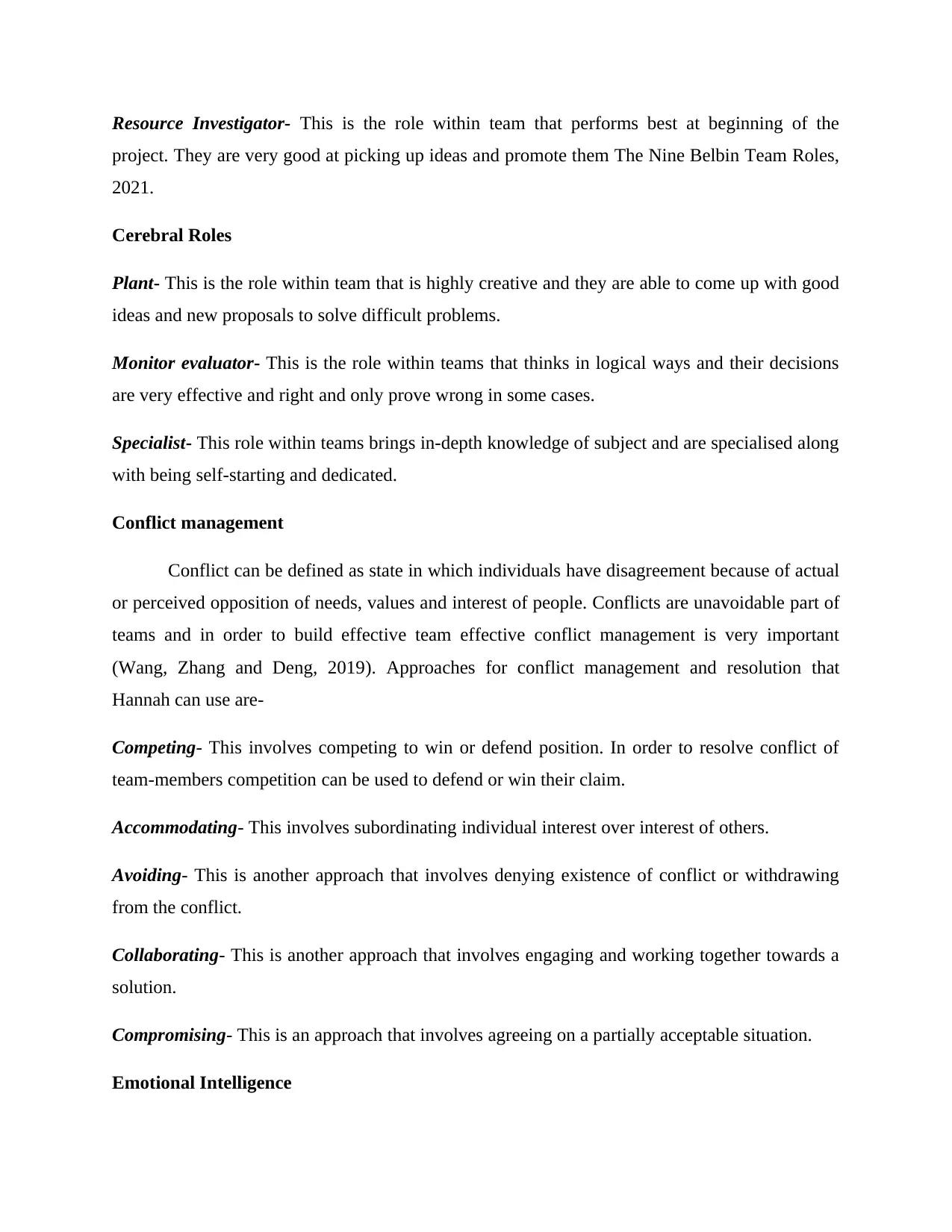
Resource Investigator- This is the role within team that performs best at beginning of the
project. They are very good at picking up ideas and promote them The Nine Belbin Team Roles,
2021.
Cerebral Roles
Plant- This is the role within team that is highly creative and they are able to come up with good
ideas and new proposals to solve difficult problems.
Monitor evaluator- This is the role within teams that thinks in logical ways and their decisions
are very effective and right and only prove wrong in some cases.
Specialist- This role within teams brings in-depth knowledge of subject and are specialised along
with being self-starting and dedicated.
Conflict management
Conflict can be defined as state in which individuals have disagreement because of actual
or perceived opposition of needs, values and interest of people. Conflicts are unavoidable part of
teams and in order to build effective team effective conflict management is very important
(Wang, Zhang and Deng, 2019). Approaches for conflict management and resolution that
Hannah can use are-
Competing- This involves competing to win or defend position. In order to resolve conflict of
team-members competition can be used to defend or win their claim.
Accommodating- This involves subordinating individual interest over interest of others.
Avoiding- This is another approach that involves denying existence of conflict or withdrawing
from the conflict.
Collaborating- This is another approach that involves engaging and working together towards a
solution.
Compromising- This is an approach that involves agreeing on a partially acceptable situation.
Emotional Intelligence
project. They are very good at picking up ideas and promote them The Nine Belbin Team Roles,
2021.
Cerebral Roles
Plant- This is the role within team that is highly creative and they are able to come up with good
ideas and new proposals to solve difficult problems.
Monitor evaluator- This is the role within teams that thinks in logical ways and their decisions
are very effective and right and only prove wrong in some cases.
Specialist- This role within teams brings in-depth knowledge of subject and are specialised along
with being self-starting and dedicated.
Conflict management
Conflict can be defined as state in which individuals have disagreement because of actual
or perceived opposition of needs, values and interest of people. Conflicts are unavoidable part of
teams and in order to build effective team effective conflict management is very important
(Wang, Zhang and Deng, 2019). Approaches for conflict management and resolution that
Hannah can use are-
Competing- This involves competing to win or defend position. In order to resolve conflict of
team-members competition can be used to defend or win their claim.
Accommodating- This involves subordinating individual interest over interest of others.
Avoiding- This is another approach that involves denying existence of conflict or withdrawing
from the conflict.
Collaborating- This is another approach that involves engaging and working together towards a
solution.
Compromising- This is an approach that involves agreeing on a partially acceptable situation.
Emotional Intelligence
Paraphrase This Document
Need a fresh take? Get an instant paraphrase of this document with our AI Paraphraser
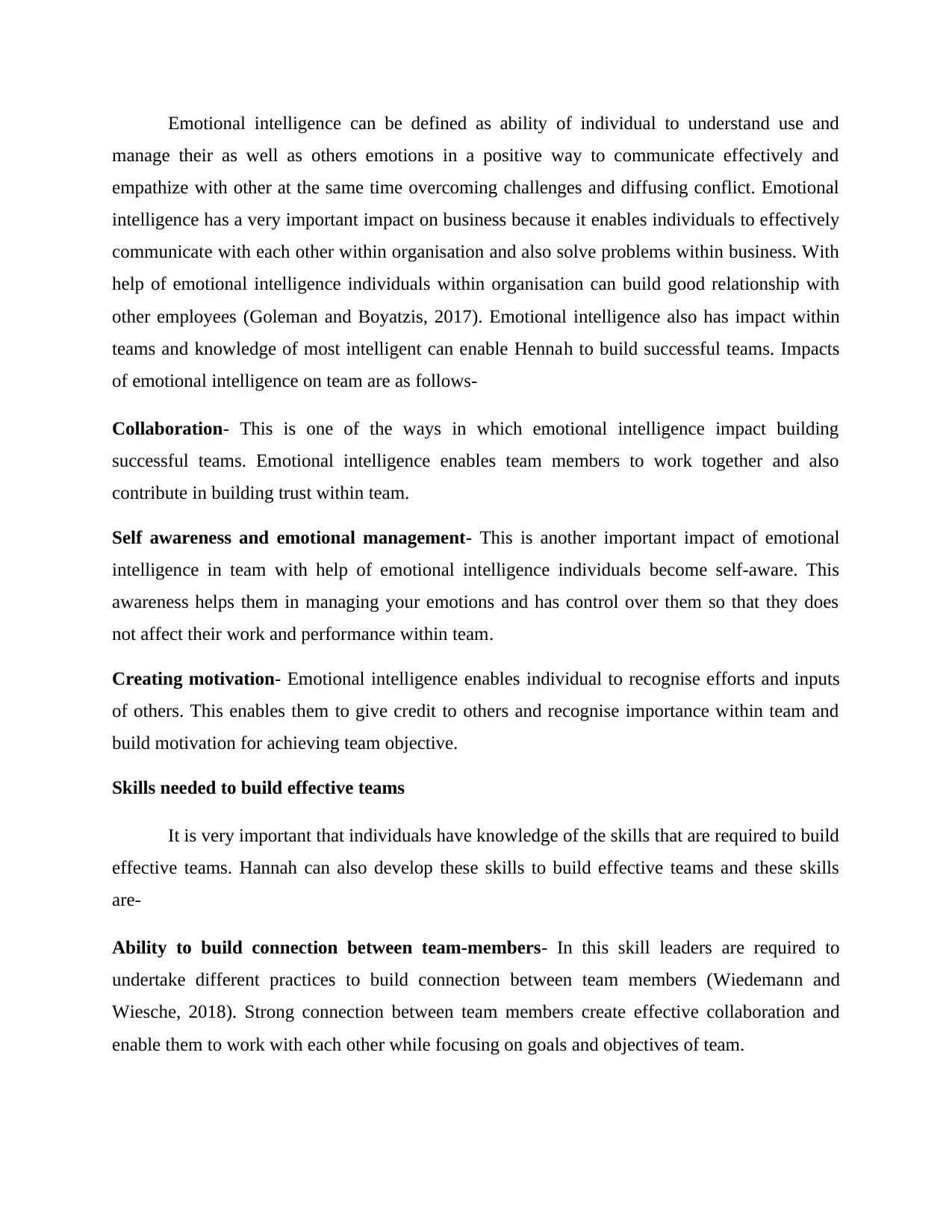
Emotional intelligence can be defined as ability of individual to understand use and
manage their as well as others emotions in a positive way to communicate effectively and
empathize with other at the same time overcoming challenges and diffusing conflict. Emotional
intelligence has a very important impact on business because it enables individuals to effectively
communicate with each other within organisation and also solve problems within business. With
help of emotional intelligence individuals within organisation can build good relationship with
other employees (Goleman and Boyatzis, 2017). Emotional intelligence also has impact within
teams and knowledge of most intelligent can enable Hennah to build successful teams. Impacts
of emotional intelligence on team are as follows-
Collaboration- This is one of the ways in which emotional intelligence impact building
successful teams. Emotional intelligence enables team members to work together and also
contribute in building trust within team.
Self awareness and emotional management- This is another important impact of emotional
intelligence in team with help of emotional intelligence individuals become self-aware. This
awareness helps them in managing your emotions and has control over them so that they does
not affect their work and performance within team.
Creating motivation- Emotional intelligence enables individual to recognise efforts and inputs
of others. This enables them to give credit to others and recognise importance within team and
build motivation for achieving team objective.
Skills needed to build effective teams
It is very important that individuals have knowledge of the skills that are required to build
effective teams. Hannah can also develop these skills to build effective teams and these skills
are-
Ability to build connection between team-members- In this skill leaders are required to
undertake different practices to build connection between team members (Wiedemann and
Wiesche, 2018). Strong connection between team members create effective collaboration and
enable them to work with each other while focusing on goals and objectives of team.
manage their as well as others emotions in a positive way to communicate effectively and
empathize with other at the same time overcoming challenges and diffusing conflict. Emotional
intelligence has a very important impact on business because it enables individuals to effectively
communicate with each other within organisation and also solve problems within business. With
help of emotional intelligence individuals within organisation can build good relationship with
other employees (Goleman and Boyatzis, 2017). Emotional intelligence also has impact within
teams and knowledge of most intelligent can enable Hennah to build successful teams. Impacts
of emotional intelligence on team are as follows-
Collaboration- This is one of the ways in which emotional intelligence impact building
successful teams. Emotional intelligence enables team members to work together and also
contribute in building trust within team.
Self awareness and emotional management- This is another important impact of emotional
intelligence in team with help of emotional intelligence individuals become self-aware. This
awareness helps them in managing your emotions and has control over them so that they does
not affect their work and performance within team.
Creating motivation- Emotional intelligence enables individual to recognise efforts and inputs
of others. This enables them to give credit to others and recognise importance within team and
build motivation for achieving team objective.
Skills needed to build effective teams
It is very important that individuals have knowledge of the skills that are required to build
effective teams. Hannah can also develop these skills to build effective teams and these skills
are-
Ability to build connection between team-members- In this skill leaders are required to
undertake different practices to build connection between team members (Wiedemann and
Wiesche, 2018). Strong connection between team members create effective collaboration and
enable them to work with each other while focusing on goals and objectives of team.
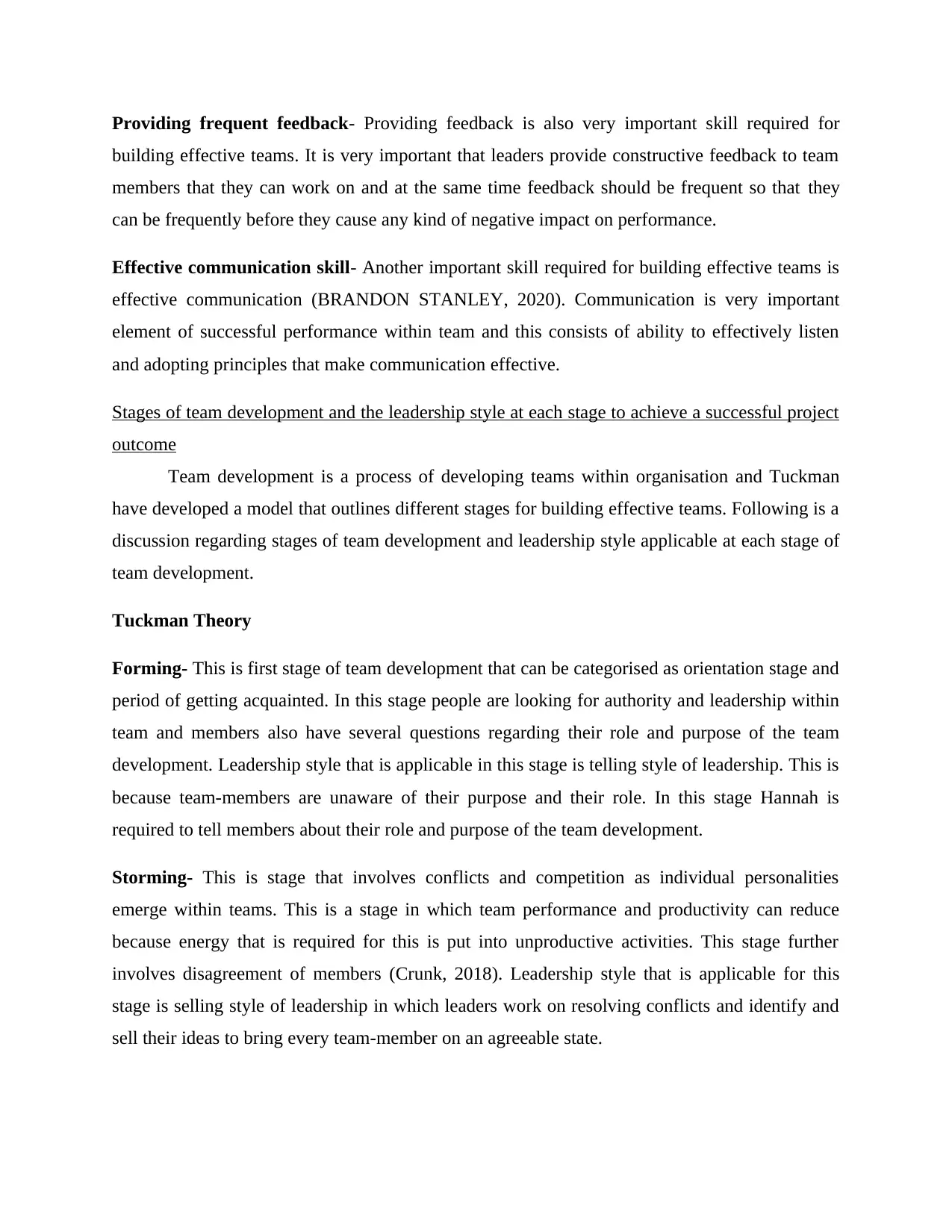
Providing frequent feedback- Providing feedback is also very important skill required for
building effective teams. It is very important that leaders provide constructive feedback to team
members that they can work on and at the same time feedback should be frequent so that they
can be frequently before they cause any kind of negative impact on performance.
Effective communication skill- Another important skill required for building effective teams is
effective communication (BRANDON STANLEY, 2020). Communication is very important
element of successful performance within team and this consists of ability to effectively listen
and adopting principles that make communication effective.
Stages of team development and the leadership style at each stage to achieve a successful project
outcome
Team development is a process of developing teams within organisation and Tuckman
have developed a model that outlines different stages for building effective teams. Following is a
discussion regarding stages of team development and leadership style applicable at each stage of
team development.
Tuckman Theory
Forming- This is first stage of team development that can be categorised as orientation stage and
period of getting acquainted. In this stage people are looking for authority and leadership within
team and members also have several questions regarding their role and purpose of the team
development. Leadership style that is applicable in this stage is telling style of leadership. This is
because team-members are unaware of their purpose and their role. In this stage Hannah is
required to tell members about their role and purpose of the team development.
Storming- This is stage that involves conflicts and competition as individual personalities
emerge within teams. This is a stage in which team performance and productivity can reduce
because energy that is required for this is put into unproductive activities. This stage further
involves disagreement of members (Crunk, 2018). Leadership style that is applicable for this
stage is selling style of leadership in which leaders work on resolving conflicts and identify and
sell their ideas to bring every team-member on an agreeable state.
building effective teams. It is very important that leaders provide constructive feedback to team
members that they can work on and at the same time feedback should be frequent so that they
can be frequently before they cause any kind of negative impact on performance.
Effective communication skill- Another important skill required for building effective teams is
effective communication (BRANDON STANLEY, 2020). Communication is very important
element of successful performance within team and this consists of ability to effectively listen
and adopting principles that make communication effective.
Stages of team development and the leadership style at each stage to achieve a successful project
outcome
Team development is a process of developing teams within organisation and Tuckman
have developed a model that outlines different stages for building effective teams. Following is a
discussion regarding stages of team development and leadership style applicable at each stage of
team development.
Tuckman Theory
Forming- This is first stage of team development that can be categorised as orientation stage and
period of getting acquainted. In this stage people are looking for authority and leadership within
team and members also have several questions regarding their role and purpose of the team
development. Leadership style that is applicable in this stage is telling style of leadership. This is
because team-members are unaware of their purpose and their role. In this stage Hannah is
required to tell members about their role and purpose of the team development.
Storming- This is stage that involves conflicts and competition as individual personalities
emerge within teams. This is a stage in which team performance and productivity can reduce
because energy that is required for this is put into unproductive activities. This stage further
involves disagreement of members (Crunk, 2018). Leadership style that is applicable for this
stage is selling style of leadership in which leaders work on resolving conflicts and identify and
sell their ideas to bring every team-member on an agreeable state.
⊘ This is a preview!⊘
Do you want full access?
Subscribe today to unlock all pages.

Trusted by 1+ million students worldwide
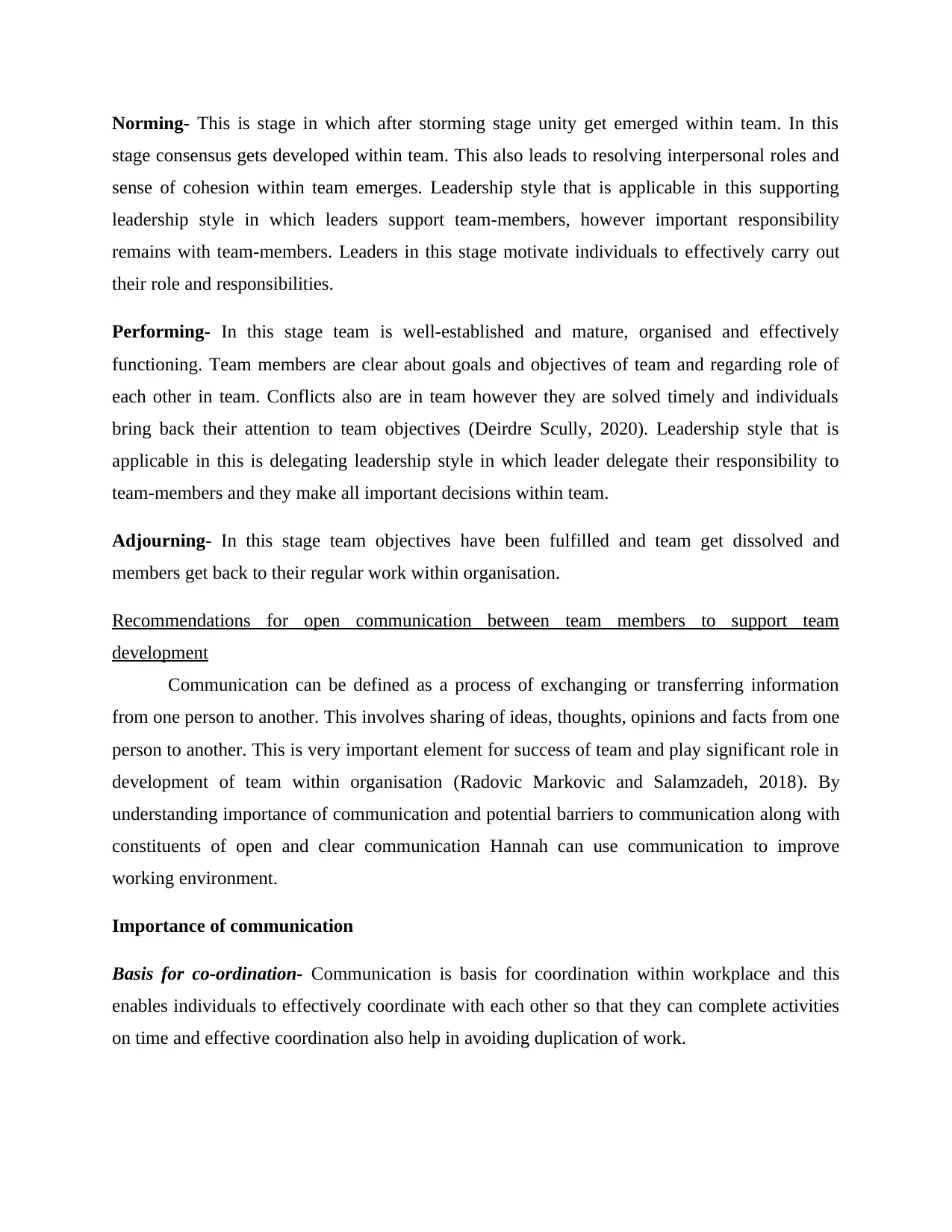
Norming- This is stage in which after storming stage unity get emerged within team. In this
stage consensus gets developed within team. This also leads to resolving interpersonal roles and
sense of cohesion within team emerges. Leadership style that is applicable in this supporting
leadership style in which leaders support team-members, however important responsibility
remains with team-members. Leaders in this stage motivate individuals to effectively carry out
their role and responsibilities.
Performing- In this stage team is well-established and mature, organised and effectively
functioning. Team members are clear about goals and objectives of team and regarding role of
each other in team. Conflicts also are in team however they are solved timely and individuals
bring back their attention to team objectives (Deirdre Scully, 2020). Leadership style that is
applicable in this is delegating leadership style in which leader delegate their responsibility to
team-members and they make all important decisions within team.
Adjourning- In this stage team objectives have been fulfilled and team get dissolved and
members get back to their regular work within organisation.
Recommendations for open communication between team members to support team
development
Communication can be defined as a process of exchanging or transferring information
from one person to another. This involves sharing of ideas, thoughts, opinions and facts from one
person to another. This is very important element for success of team and play significant role in
development of team within organisation (Radovic Markovic and Salamzadeh, 2018). By
understanding importance of communication and potential barriers to communication along with
constituents of open and clear communication Hannah can use communication to improve
working environment.
Importance of communication
Basis for co-ordination- Communication is basis for coordination within workplace and this
enables individuals to effectively coordinate with each other so that they can complete activities
on time and effective coordination also help in avoiding duplication of work.
stage consensus gets developed within team. This also leads to resolving interpersonal roles and
sense of cohesion within team emerges. Leadership style that is applicable in this supporting
leadership style in which leaders support team-members, however important responsibility
remains with team-members. Leaders in this stage motivate individuals to effectively carry out
their role and responsibilities.
Performing- In this stage team is well-established and mature, organised and effectively
functioning. Team members are clear about goals and objectives of team and regarding role of
each other in team. Conflicts also are in team however they are solved timely and individuals
bring back their attention to team objectives (Deirdre Scully, 2020). Leadership style that is
applicable in this is delegating leadership style in which leader delegate their responsibility to
team-members and they make all important decisions within team.
Adjourning- In this stage team objectives have been fulfilled and team get dissolved and
members get back to their regular work within organisation.
Recommendations for open communication between team members to support team
development
Communication can be defined as a process of exchanging or transferring information
from one person to another. This involves sharing of ideas, thoughts, opinions and facts from one
person to another. This is very important element for success of team and play significant role in
development of team within organisation (Radovic Markovic and Salamzadeh, 2018). By
understanding importance of communication and potential barriers to communication along with
constituents of open and clear communication Hannah can use communication to improve
working environment.
Importance of communication
Basis for co-ordination- Communication is basis for coordination within workplace and this
enables individuals to effectively coordinate with each other so that they can complete activities
on time and effective coordination also help in avoiding duplication of work.
Paraphrase This Document
Need a fresh take? Get an instant paraphrase of this document with our AI Paraphraser
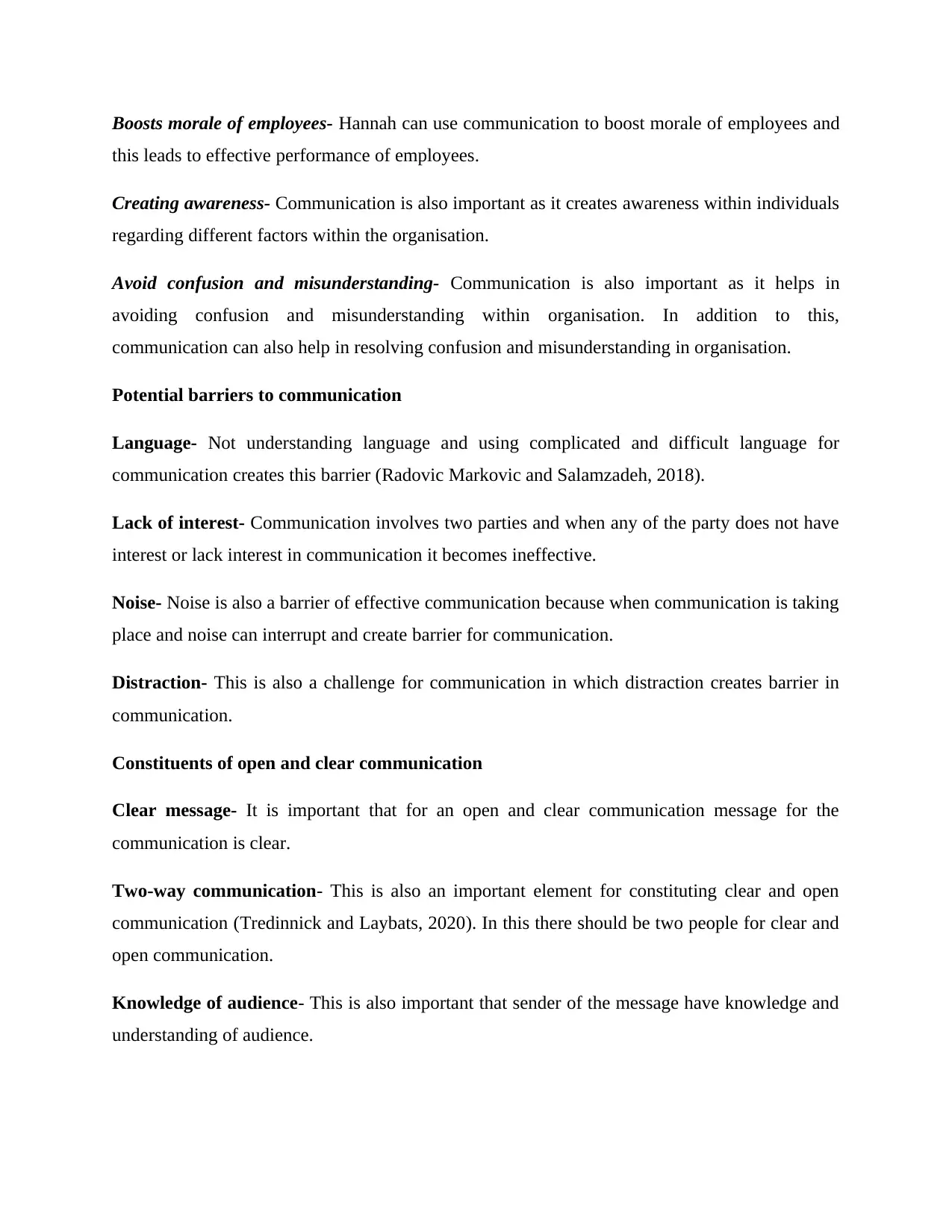
Boosts morale of employees- Hannah can use communication to boost morale of employees and
this leads to effective performance of employees.
Creating awareness- Communication is also important as it creates awareness within individuals
regarding different factors within the organisation.
Avoid confusion and misunderstanding- Communication is also important as it helps in
avoiding confusion and misunderstanding within organisation. In addition to this,
communication can also help in resolving confusion and misunderstanding in organisation.
Potential barriers to communication
Language- Not understanding language and using complicated and difficult language for
communication creates this barrier (Radovic Markovic and Salamzadeh, 2018).
Lack of interest- Communication involves two parties and when any of the party does not have
interest or lack interest in communication it becomes ineffective.
Noise- Noise is also a barrier of effective communication because when communication is taking
place and noise can interrupt and create barrier for communication.
Distraction- This is also a challenge for communication in which distraction creates barrier in
communication.
Constituents of open and clear communication
Clear message- It is important that for an open and clear communication message for the
communication is clear.
Two-way communication- This is also an important element for constituting clear and open
communication (Tredinnick and Laybats, 2020). In this there should be two people for clear and
open communication.
Knowledge of audience- This is also important that sender of the message have knowledge and
understanding of audience.
this leads to effective performance of employees.
Creating awareness- Communication is also important as it creates awareness within individuals
regarding different factors within the organisation.
Avoid confusion and misunderstanding- Communication is also important as it helps in
avoiding confusion and misunderstanding within organisation. In addition to this,
communication can also help in resolving confusion and misunderstanding in organisation.
Potential barriers to communication
Language- Not understanding language and using complicated and difficult language for
communication creates this barrier (Radovic Markovic and Salamzadeh, 2018).
Lack of interest- Communication involves two parties and when any of the party does not have
interest or lack interest in communication it becomes ineffective.
Noise- Noise is also a barrier of effective communication because when communication is taking
place and noise can interrupt and create barrier for communication.
Distraction- This is also a challenge for communication in which distraction creates barrier in
communication.
Constituents of open and clear communication
Clear message- It is important that for an open and clear communication message for the
communication is clear.
Two-way communication- This is also an important element for constituting clear and open
communication (Tredinnick and Laybats, 2020). In this there should be two people for clear and
open communication.
Knowledge of audience- This is also important that sender of the message have knowledge and
understanding of audience.
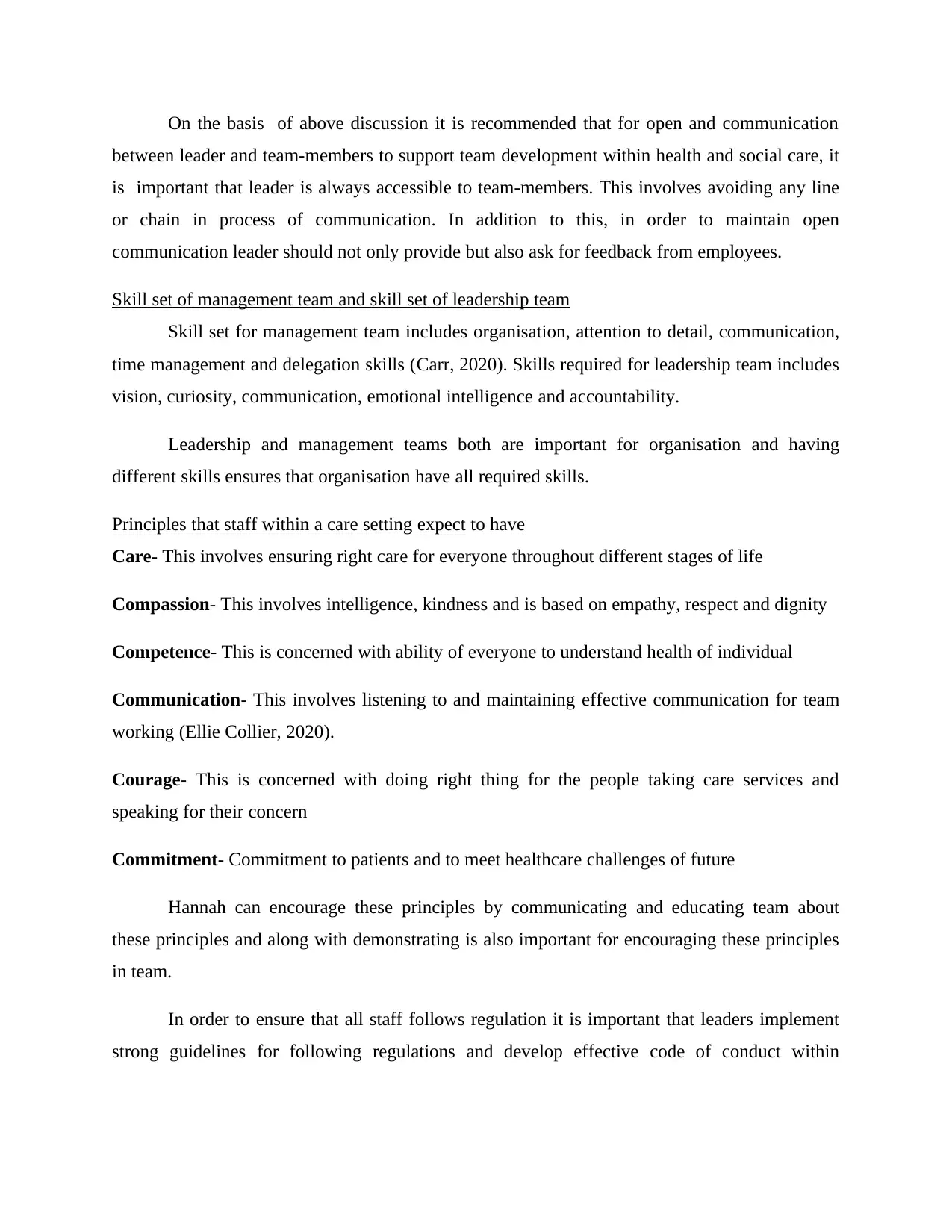
On the basis of above discussion it is recommended that for open and communication
between leader and team-members to support team development within health and social care, it
is important that leader is always accessible to team-members. This involves avoiding any line
or chain in process of communication. In addition to this, in order to maintain open
communication leader should not only provide but also ask for feedback from employees.
Skill set of management team and skill set of leadership team
Skill set for management team includes organisation, attention to detail, communication,
time management and delegation skills (Carr, 2020). Skills required for leadership team includes
vision, curiosity, communication, emotional intelligence and accountability.
Leadership and management teams both are important for organisation and having
different skills ensures that organisation have all required skills.
Principles that staff within a care setting expect to have
Care- This involves ensuring right care for everyone throughout different stages of life
Compassion- This involves intelligence, kindness and is based on empathy, respect and dignity
Competence- This is concerned with ability of everyone to understand health of individual
Communication- This involves listening to and maintaining effective communication for team
working (Ellie Collier, 2020).
Courage- This is concerned with doing right thing for the people taking care services and
speaking for their concern
Commitment- Commitment to patients and to meet healthcare challenges of future
Hannah can encourage these principles by communicating and educating team about
these principles and along with demonstrating is also important for encouraging these principles
in team.
In order to ensure that all staff follows regulation it is important that leaders implement
strong guidelines for following regulations and develop effective code of conduct within
between leader and team-members to support team development within health and social care, it
is important that leader is always accessible to team-members. This involves avoiding any line
or chain in process of communication. In addition to this, in order to maintain open
communication leader should not only provide but also ask for feedback from employees.
Skill set of management team and skill set of leadership team
Skill set for management team includes organisation, attention to detail, communication,
time management and delegation skills (Carr, 2020). Skills required for leadership team includes
vision, curiosity, communication, emotional intelligence and accountability.
Leadership and management teams both are important for organisation and having
different skills ensures that organisation have all required skills.
Principles that staff within a care setting expect to have
Care- This involves ensuring right care for everyone throughout different stages of life
Compassion- This involves intelligence, kindness and is based on empathy, respect and dignity
Competence- This is concerned with ability of everyone to understand health of individual
Communication- This involves listening to and maintaining effective communication for team
working (Ellie Collier, 2020).
Courage- This is concerned with doing right thing for the people taking care services and
speaking for their concern
Commitment- Commitment to patients and to meet healthcare challenges of future
Hannah can encourage these principles by communicating and educating team about
these principles and along with demonstrating is also important for encouraging these principles
in team.
In order to ensure that all staff follows regulation it is important that leaders implement
strong guidelines for following regulations and develop effective code of conduct within
⊘ This is a preview!⊘
Do you want full access?
Subscribe today to unlock all pages.

Trusted by 1+ million students worldwide
1 out of 15
Related Documents
Your All-in-One AI-Powered Toolkit for Academic Success.
+13062052269
info@desklib.com
Available 24*7 on WhatsApp / Email
![[object Object]](/_next/static/media/star-bottom.7253800d.svg)
Unlock your academic potential
Copyright © 2020–2025 A2Z Services. All Rights Reserved. Developed and managed by ZUCOL.





